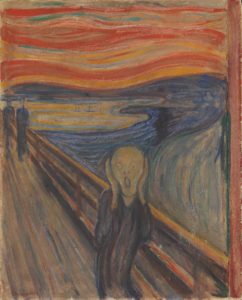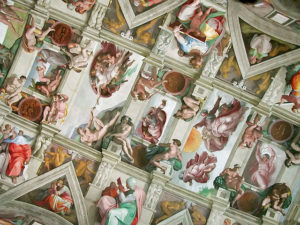Myths, stories, and apocrypha have always surrounded art and artists. Some start with a grain of truth, while others are just made up entirely. Here is just a short collection of some of my favorites…
What is The Scream?
Edvard Munch’s The Scream is one of the world’s most iconic modern paintings. It shows a person with an anguished look gripping their face in the middle of a pathway. While one might assume that the work’s title refers to the subject’s action, interestingly enough it does not. The title does not refer to the screaming subject but the subject hearing a scream. Some have posited that they are hearing screams from a nearby asylum, but it is far more mystical than that. Munch originally exhibited The Scream under the German title Der Schrei der Natur, or The Scream of Nature. Munch originally conceived the idea while walking across a path over a fjord near Oslo. In January 1892, Munch wrote, “I stopped and looked out over the fjord – the sun was setting, and the clouds turning blood red. I sensed a scream passing through nature; it seemed to me that I heard the scream.” He had likely suffered a panic attack at this moment. Munch makes the red sky appear as thought it is vibrating like an actual scream reverberating through nature. However, the other figures further along the path seem undisturbed, as if the scream is only in the subject’s head.
Van Gogh, the Unrecognized Genius
One of the most common factoids about Vincent van Gogh is how he was not fully recognized outside of artistic circles in his lifetime. One myth that gets a lot of attention is that he only sold one painting in his lifetime when Anna Boch bought The Red Vineyard at Arles. However, this was far from the only painting Van Gogh sold. He received commissions rather early in his career, most notably from his uncle Cornelis van Gogh, who commissioned him to create a series of cityscapes of The Hague in 1882. Though he went unrecognized for a good portion of his career, Van Gogh did start to gain some visibility towards the end of his life. Around 1887, three years before his suicide, patrons began hanging his work at their cafés and shops. Plus, he not only sold his own paintings, but he sold those of others as well. The Van Gogh family was a family of art dealers in the Netherlands for generations. Vincent’s uncle, also named Vincent but called Uncle Cent, was a partner at Goupil & Cie, one of continental Europe’s most prestigious art dealers. Cent even ran their location in The Hague for a time, where, starting in 1869, he employed his nephew Vincent, aged 16. Vincent worked at the Hague and London locations, doing very well at the former but less so at the latter.
Michelangelo On His Back
Irving Stone’s biographical novel The Agony and the Ecstasy, about the life of Michelangelo Buonarroti, is one of the greatest books about art I have ever read. But if you don’t have the time for that, the 1965 film adaptation with Charleton Heston as Michelangelo, containing a small fraction of the book’s contents, is a beautiful movie. One of the most iconic images, shown in both the book and the film, is Michelangelo lying on his back on the scaffolding he’s constructed, paint dripping onto his face as he paints the ceiling of the Sistine Chapel. While it is a striking image, this is unfortunately another myth. This misconception comes from one of his contemporaries, Paolo Giovio, who wrote that this must have been how Michelangelo created the monumental work. However, writers, chroniclers, biographers, and other contemporaries agree that Michelangelo and his assistants stood up to paint. They stood on the scaffolding, crooking their necks the entire time, causing neck and back pain that Michelangelo wrote about later in life, providing a crude drawing of himself painting on the ceiling while standing.
Jackson Pollock’s Work Playlist
Jackson Pollock’s paintings are some of the textbook definitions of ‘modern art’. His splatter technique, which he called “action painting”, was innovative through its free-flowing, almost improvisational style. It was similar to another art form, one that Pollock himself enjoyed very much: jazz. His love of classic New Orleans jazz, swing, and the songs of Billie Holiday are well-noted by his friends and contemporaries. In 1999, the Museum of Modern Art released a compilation CD called Jackson Pollock: Jazz, featuring Jelly Roll Morton, Artie Shaw, Fats Waller, and others from Pollock’s collection. This has given rise to the story that Jackson Pollock painted while listening to jazz. While it’s a powerful image, it is unfortunately untrue. Pollock’s primary studio was a barn next to his home on Long Island. It had no power source, so listening to the radio or jazz records would have been difficult.




